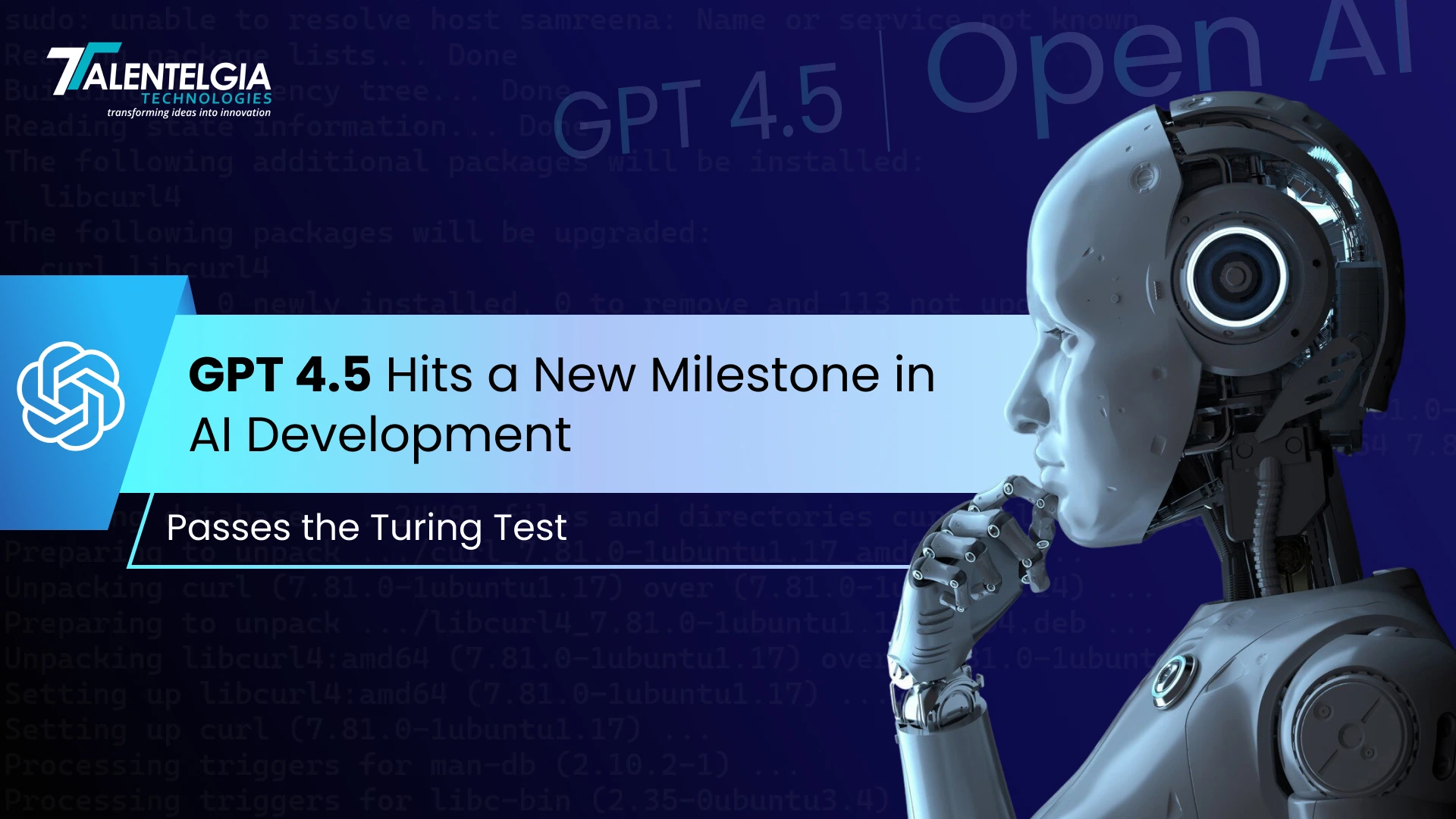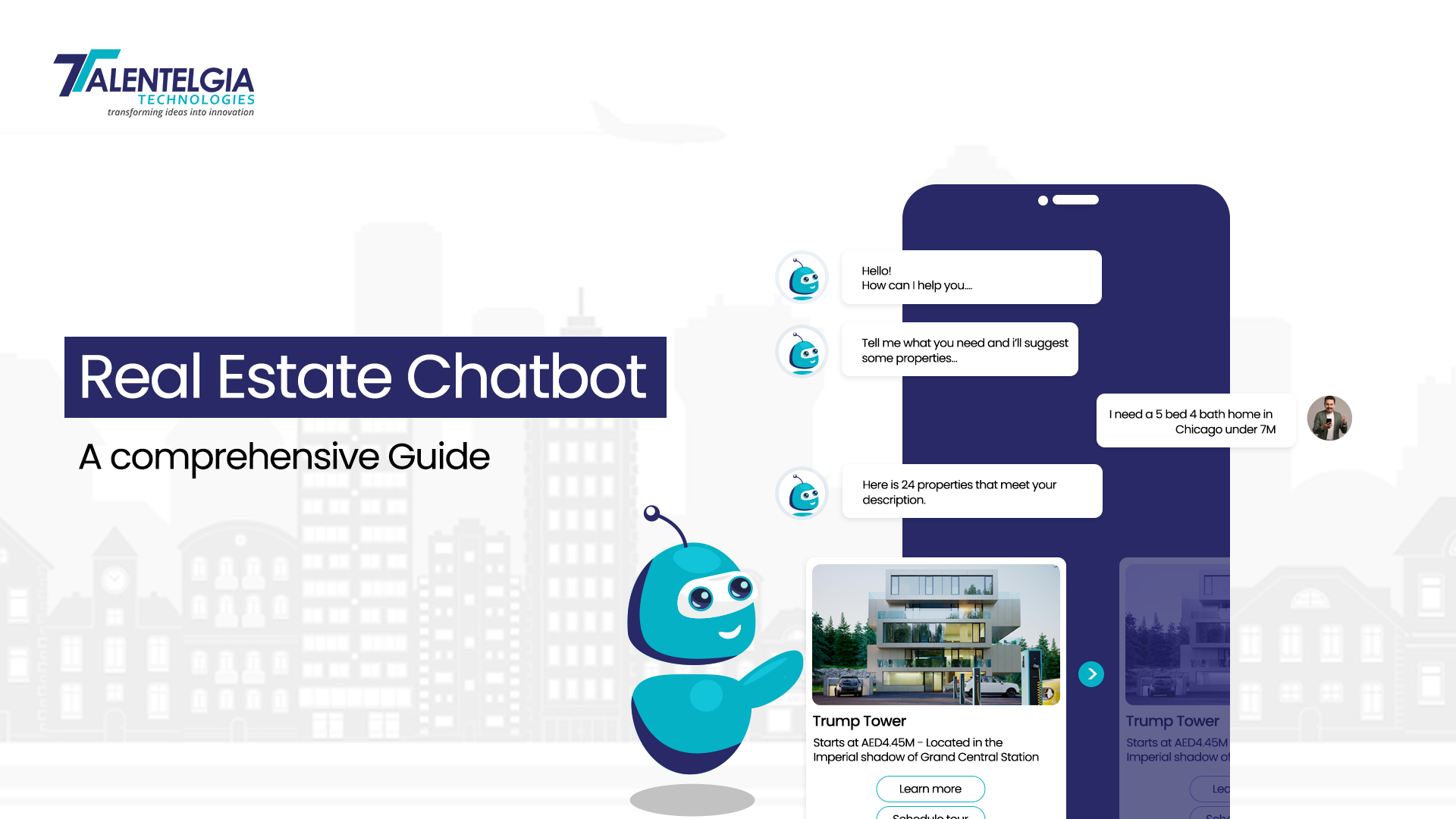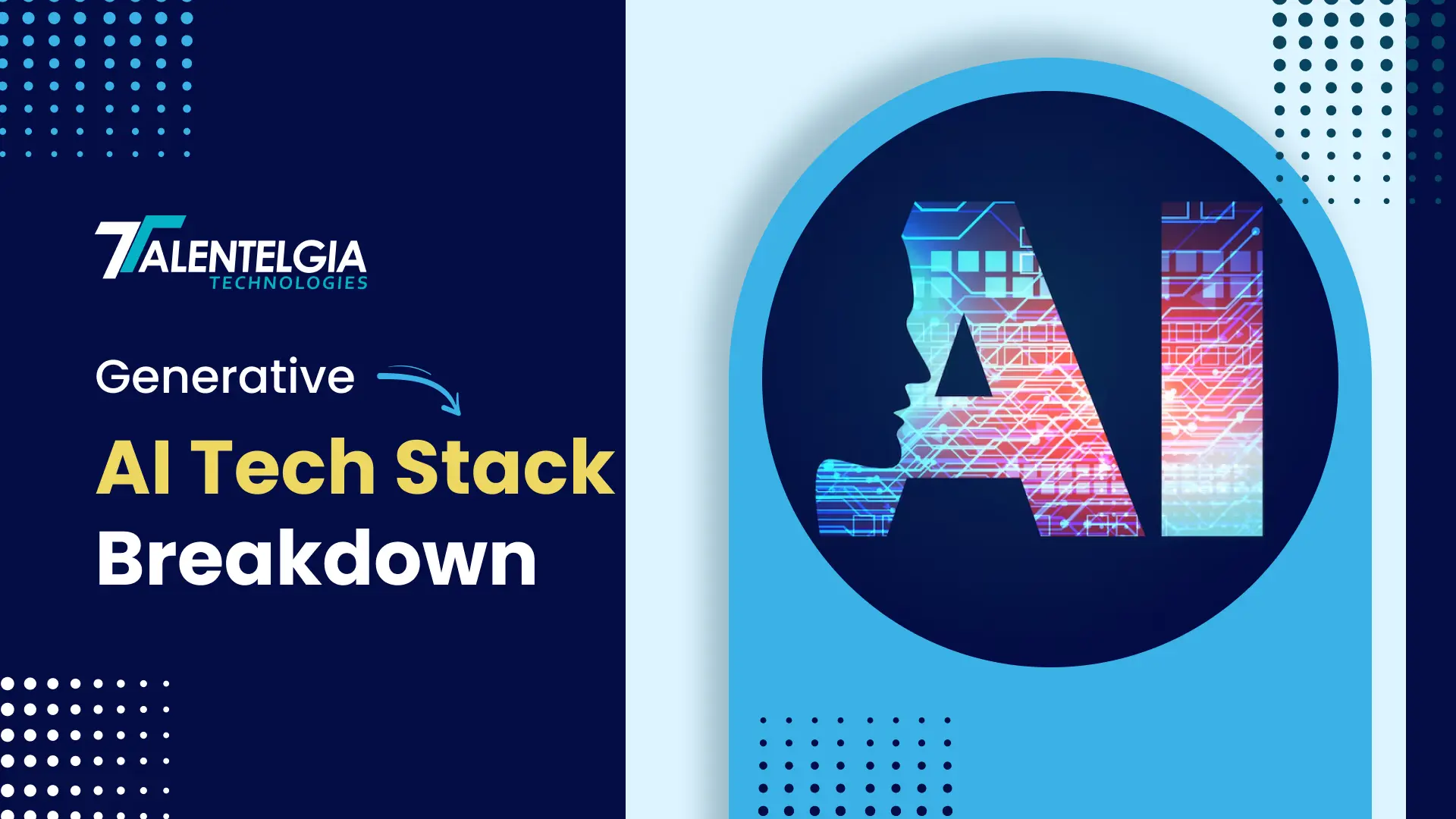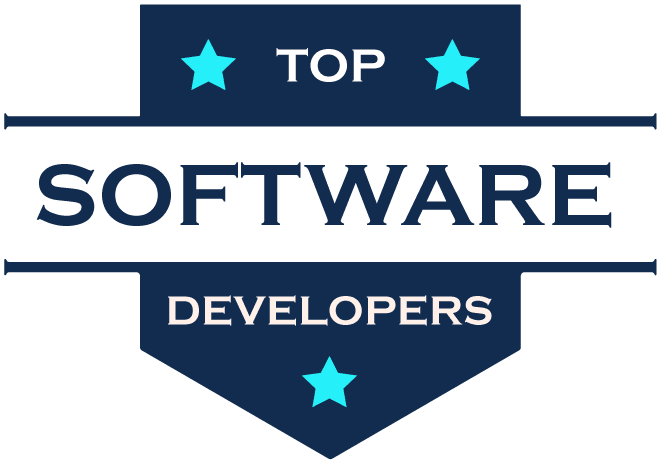OpenAI’s GPT-4.5 has crossed another milestone – it has passed the Turing Test. Recorded by researchers at the University of California, San Diego, this represents not only a technical accomplishment but a turning point for human interaction with AI.
As businesses deal with what this means, one truth is already very clear— AI is no longer the future. It’s here. GPT-4.5’s success shows the potential of AI to be integrated into our daily lives.
GPT-4.5’s Breakthrough Performance
The UC San Diego examination used a three-party Turing Test arrangement. They had five-minute text discussions with both a human and an AI model and speculated which was human and vice versa.

GPT-4.5, when asked to assume a human persona, hit a phenomenal 73 percent success rate—meaning evaluators thought it was human 73 percent of the time. In some cases, the machine did better than real humans, who were correctly identified less often. In contrast, other models, such as Meta’s Llama-3.1-405, B achieved 56% with a near-identical persona prompt, and earlier systems like ELIZA (1960s-era) and OpenAI’s GPT-4o performed far worse, at 5% and 27%, respectively.
One of the main insights of the study is the importance of prompting. Without a persona prompt, GPT-4.5’s accuracy fell to 36 percent, showing how much the results rely on instructions to mimic human qualities.
Yet that very versatility is what sets GPT-4.5 apart. Its capacity to produce natural, contextually accurate responses has taken it to a level above previous models. It is on par with the threshold commonly referenced for passing the Turing Test (at least 50%, as shown in the overview given with historical comparisons of AIs [graph: “ChatGPT and Success Rates in Turing Test Evaluations”]). The graph, frequently cited in AI research, depicts ChatGPT and its successive models steadily climbing toward and now exceeding this value, with GPT-4.5 marking a clear peak.
What Is the Turing Test?
Named after the British mathematician and computer scientist Alan Turing, this test was credited with its conception in his landmark 1950 paper “Computing Machinery and Intelligence.” It is a standard for assessing a machine’s ability to demonstrate human-level intelligence. In its classical form, the test consists of three players: a human judge, a human respondent, and a machine. The evaluator has text-based chats with both the human and machine, unbeknownst to them, which is which. If the evaluator is unable to determine which of the participants is the machine and which is the human, the machine is considered to have passed the test. The Turing Test is not an assessment of a machine’s ability to think or comprehend as a human does; instead, it tests a machine’s ability to appear convincingly human. It has long been used as a symbolic yardstick for progress in AI.
What Else Should You Know?
GPT-4.5’s milestone is more than a technical advancement; it marks a shift in how we think about and interact with AI. Since this model is so good at NLP, it makes it seem like AI systems are getting closer to people in conversations. This doesn’t affect specific verticals like e-commerce, delivering personalized customer experience (CX), or experience-led initiatives. Such technology can help businesses to run more efficiently, tailor user experiences, and scale in innovative ways.
Broader Societal Impact
GPT-4.5’s success raises new questions about AI’s place in society. On platforms like X, responses vary from enthusiasm— talking about its palllications in day-to-day life. If AI can impersonate humans well enough, what’s this going to do to trust, authenticity, and jobs? The study’s results add to the debate around regulation, ethics, and the need for transparency when launching AI.
Conclusion
GPT-4.5 passing the Turing Test, where one can’t distinguish human from AI, is a huge milestone in the AI industry. It’s a reminder of how quickly A.I. is developing — and how AI models now so convincingly imitate human speech. However, it is equally important to understand its intricacies to use it for the growth of your business.
We at Talentelgia help every business leverage this powerful technology. From automating workflows to enhancing customer engagement and developing intelligent AI-powered tools, we transform innovation into actual results. As GPT-4.5 redefines possibilities, our team continues transforming technological innovations into hard-earned success.


 Healthcare App Development Services
Healthcare App Development Services
 Real Estate Web Development Services
Real Estate Web Development Services
 E-Commerce App Development Services
E-Commerce App Development Services E-Commerce Web Development Services
E-Commerce Web Development Services Blockchain E-commerce Development Company
Blockchain E-commerce Development Company
 Fintech App Development Services
Fintech App Development Services Fintech Web Development
Fintech Web Development Blockchain Fintech Development Company
Blockchain Fintech Development Company
 E-Learning App Development Services
E-Learning App Development Services
 Restaurant App Development Company
Restaurant App Development Company
 Mobile Game Development Company
Mobile Game Development Company
 Travel App Development Company
Travel App Development Company
 Automotive Web Design
Automotive Web Design
 AI Traffic Management System
AI Traffic Management System
 AI Inventory Management Software
AI Inventory Management Software
 AI Software Development
AI Software Development  AI Development Company
AI Development Company  AI App Development Services
AI App Development Services  ChatGPT integration services
ChatGPT integration services  AI Integration Services
AI Integration Services  Generative AI Development Services
Generative AI Development Services  Natural Language Processing Company
Natural Language Processing Company Machine Learning Development
Machine Learning Development  Machine learning consulting services
Machine learning consulting services  Blockchain Development
Blockchain Development  Blockchain Software Development
Blockchain Software Development  Smart Contract Development Company
Smart Contract Development Company  NFT Marketplace Development Services
NFT Marketplace Development Services  Asset Tokenization Company
Asset Tokenization Company DeFi Wallet Development Company
DeFi Wallet Development Company Mobile App Development
Mobile App Development  IOS App Development
IOS App Development  Android App Development
Android App Development  Cross-Platform App Development
Cross-Platform App Development  Augmented Reality (AR) App Development
Augmented Reality (AR) App Development  Virtual Reality (VR) App Development
Virtual Reality (VR) App Development  Web App Development
Web App Development  SaaS App Development
SaaS App Development Flutter
Flutter  React Native
React Native  Swift (IOS)
Swift (IOS)  Kotlin (Android)
Kotlin (Android)  Mean Stack Development
Mean Stack Development  AngularJS Development
AngularJS Development  MongoDB Development
MongoDB Development  Nodejs Development
Nodejs Development  Database Development
Database Development Ruby on Rails Development
Ruby on Rails Development Expressjs Development
Expressjs Development  Full Stack Development
Full Stack Development  Web Development Services
Web Development Services  Laravel Development
Laravel Development  LAMP Development
LAMP Development  Custom PHP Development
Custom PHP Development  .Net Development
.Net Development  User Experience Design Services
User Experience Design Services  User Interface Design Services
User Interface Design Services  Automated Testing
Automated Testing  Manual Testing
Manual Testing  Digital Marketing Services
Digital Marketing Services 
 Ride-Sharing And Taxi Services
Ride-Sharing And Taxi Services Food Delivery Services
Food Delivery Services Grocery Delivery Services
Grocery Delivery Services Transportation And Logistics
Transportation And Logistics Car Wash App
Car Wash App Home Services App
Home Services App ERP Development Services
ERP Development Services CMS Development Services
CMS Development Services LMS Development
LMS Development CRM Development
CRM Development DevOps Development Services
DevOps Development Services AI Business Solutions
AI Business Solutions AI Cloud Solutions
AI Cloud Solutions AI Chatbot Development
AI Chatbot Development API Development
API Development Blockchain Product Development
Blockchain Product Development Cryptocurrency Wallet Development
Cryptocurrency Wallet Development About Talentelgia
About Talentelgia  Our Team
Our Team  Our Culture
Our Culture 
 Healthcare App Development Services
Healthcare App Development Services Real Estate Web Development Services
Real Estate Web Development Services E-Commerce App Development Services
E-Commerce App Development Services E-Commerce Web Development Services
E-Commerce Web Development Services Blockchain E-commerce
Development Company
Blockchain E-commerce
Development Company Fintech App Development Services
Fintech App Development Services Finance Web Development
Finance Web Development Blockchain Fintech
Development Company
Blockchain Fintech
Development Company E-Learning App Development Services
E-Learning App Development Services Restaurant App Development Company
Restaurant App Development Company Mobile Game Development Company
Mobile Game Development Company Travel App Development Company
Travel App Development Company Automotive Web Design
Automotive Web Design AI Traffic Management System
AI Traffic Management System AI Inventory Management Software
AI Inventory Management Software AI Software Development
AI Software Development AI Development Company
AI Development Company ChatGPT integration services
ChatGPT integration services AI Integration Services
AI Integration Services Machine Learning Development
Machine Learning Development Machine learning consulting services
Machine learning consulting services Blockchain Development
Blockchain Development Blockchain Software Development
Blockchain Software Development Smart contract development company
Smart contract development company NFT marketplace development services
NFT marketplace development services IOS App Development
IOS App Development Android App Development
Android App Development Cross-Platform App Development
Cross-Platform App Development Augmented Reality (AR) App
Development
Augmented Reality (AR) App
Development Virtual Reality (VR) App Development
Virtual Reality (VR) App Development Web App Development
Web App Development Flutter
Flutter React
Native
React
Native Swift
(IOS)
Swift
(IOS) Kotlin (Android)
Kotlin (Android) MEAN Stack Development
MEAN Stack Development AngularJS Development
AngularJS Development MongoDB Development
MongoDB Development Nodejs Development
Nodejs Development Database development services
Database development services Ruby on Rails Development services
Ruby on Rails Development services Expressjs Development
Expressjs Development Full Stack Development
Full Stack Development Web Development Services
Web Development Services Laravel Development
Laravel Development LAMP
Development
LAMP
Development Custom PHP Development
Custom PHP Development User Experience Design Services
User Experience Design Services User Interface Design Services
User Interface Design Services Automated Testing
Automated Testing Manual
Testing
Manual
Testing About Talentelgia
About Talentelgia Our Team
Our Team Our Culture
Our Culture

















 Write us on:
Write us on:  Business queries:
Business queries:  HR:
HR: 




